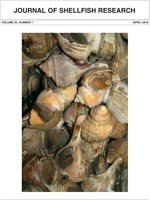Changes in the timing and interaction of seasonal high temperatures and low salinities as predicted by climate change models could dramatically alter oyster population dynamics. Little is known explicitly about how low salinity and high temperature combinations affect spat (<25mm), seed (25–75mm), andmarket (>75mm) oyster growth and mortality. Using field and laboratory studies, this project quantified the combined effects of extremely low salinities (<5) and high temperatures (>30°C) on growth and survival of spat, seed, andmarket-sized oysters. In 2012 and 2013, hatchery-produced oysters were placed in open and closed cages at three sites in Breton Sound, LA, along a salinity gradient that typically ranged from 5 to 20. Growth and mortality were recorded monthly. Regardless of size class, oysters at the lowest salinity site (annualmean = 4.8) experienced significantly highermortality and lower growth than oysters located in higher salinity sites (annual means = 11.1 and 13.0, respectively); furthermore, all oysters in open cages at the two higher salinity sites experienced higher mortality than in closed cages, likely due to predation. To explicitly examine oyster responses to extreme low salinity and high temperature combinations, a series of laboratory studies were conducted. Oysters were placed in 18 tanks in a fully crossed temperature (25°C, 32°C) by salinity (1, 5, and 15) study with three replicates, and repeated at least twice for each oyster size class. Regardless of temperature, seed and market oysters held in low salinity tanks (salinity 1) experienced 100% mortality within 7 days. In contrast, at salinity 5, temperature significantly affected mortality; oysters in all size classes experienced greater than 50%mortality at 32°C and less than 40%mortality at 25°C. At the highest salinity tested (15), only market-sized oysters held at 32°C experienced significant mortality (>60%). These studies demonstrate that high water temperatures (>30°C) and low salinities (<5) negatively impact oyster growth and survival differentially and that high temperatures alone may negatively impact market-sized oysters. It is critical to understand the potential impacts of climate and anthropogenic changes on oyster resources to better adapt and manage for long-term sustainability.
How to translate text using browser tools
1 April 2016
Increased Temperatures Combined with Lowered Salinities Differentially Impact Oyster Size Class Growth and Mortality
Molly Rybovich,
Megan K. La Peyre,
Steven G. Hall,
Jerome F. La Peyre
ACCESS THE FULL ARTICLE

Journal of Shellfish Research
Vol. 35 • No. 1
April 2016
Vol. 35 • No. 1
April 2016
climate change
Crassostrea virginica
eastern oyster
estuary
northern Gulf of Mexico




